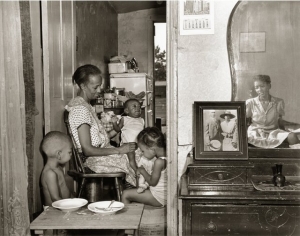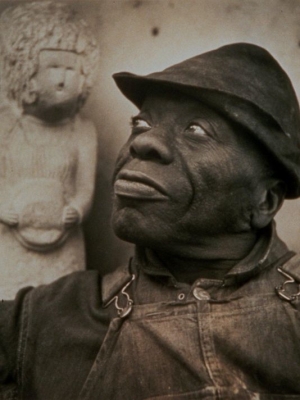|
Displaying items by tag: african american art
The St. Louis Art Museum has announced a significant acquisition: “Sunday Morning Breakfast,” a 1943 painting by the highly regarded African-American folk artist Horace Pippin.
The painting, the purchase of which was approved by the museum’s board of commissioners on Monday evening, cost $1.5 million.
Crystal Bridges Museum of American Art recently acquired Maya’s Quilt of Life, 1989, (acrylic on canvas and painted, dyed and pieced fabrics) by Faith Ringgold, from the art collection of the late author and activist, Maya Angelou. The work hung in Angelou’s home and was commissioned by Oprah Winfrey for Angelou’s 61st birthday.
Ringgold is well-known for her painted story quilts, which unite a tradition of representational painting with the rich history of quilting in the African-American community. The border of Maya’s Quilt of Life is made from pieced-together fabric that frames Angelou, who is surrounded by flowers in her signature patterned African dress and head wrap.
Maya Angelou, the pioneering African American author and poet, also had quite the art collection, featuring a number of prominent African American artists. On September 15, Swann Galleries' African-American fine art department will offer her collection at the sale "The Art Collection of Maya Angelou."
Of the over 500 artworks the author owned when she died in May of 2014, 43 pieces will be available in the Swann sale, which will also run on eBay's live auction platform.
Thanks to the extraordinary generosity of the late Dr. Herbert J. Kayden of New York City and his daughter Joelle Kayden, Stanford MBA ’81, of Washington, D.C., the Cantor Arts Center at Stanford University now holds one of the largest collections in any museum of the work of Jacob Lawrence (1917–2000). Lawrence is among the most important artists of the 20th century and is a leading voice in the artistic portrayal of the African American experience. Staunch supporters of Stanford and the Cantor’s educational mission, the Kaydens have gifted to the museum an unparalleled collection of 56 works by Lawrence and one by his wife, Gwendolyn Knight Lawrence. The gift is comprised of five paintings, 11 drawings, 39 prints and one illustrated book, all dating between 1943 and 1998 and all given in memory of Dr. Gabrielle H. Reem, who is Herbert Kayden’s wife and Joelle Kayden’s mother.

Gordon Parks (1912-2006), one of the most celebrated African-American photographers of all time, is the subject of a new exhibition of groundbreaking photographs at the Museum of Fine Arts, Boston. "Gordon Parks: Back to Fort Scott" (January 17–September 13, 2015) traces Parks’ return to his hometown of Fort Scott, Kansas and then to other Midwestern cities, to track down and photograph each of his childhood classmates. On view in the MFA’s Art of the Americas Wing, the exhibition’s 42 photographs were from a series originally meant to accompany a Life magazine photo essay—but for reasons unknown, the story was never published. The images depict the realities of life under segregation in 1950—presenting a rarely seen view of everyday lives of African-American citizens in the years before the Civil Rights movement began in earnest. One of the most personal and captivating of all Parks’ projects, the images, now owned by The Gordon Parks Foundation, represent a rare and little-known group within Parks’ oeuvre.
The National Gallery of Art has added 6,430 works from the Corcoran Gallery of Art to its collection in a historic effort that improves its standing as Washington’s flagship art institution while attempting to preserve the legacy of what was the city’s oldest private art museum.
The acquisitions — described by curators as dazzling, stunning and transformative — will dramatically alter the National Gallery’s holdings of contemporary art, sculpture, American paintings and works on paper. And because they are rich with works by women and African Americans, the pieces diversify the National Gallery’s collection.
The Arkansas Arts Center, the state's premiere center for visual and performing arts, presents "30 Americans," on view April 10 through June 21, 2015, in the Jeannette Edris Rockefeller and Townsend Wolfe Galleries.
"This exhibition presents a sweeping survey of artwork by many of the most influential African-American artists of the last four decades," said Arkansas Arts Center executive director Todd Herman. "For years, I've searched for an exhibition of this kind but couldn't quite find what I was looking for – an exhibition with powerful interpretations of cultural identity and artistic legacy. When I came across '30 Americans,' I knew this was exactly what I wanted patrons and visitors of the Arts Center to experience. These themes are universal in nature and speak to the larger human experience."
In 1898, the then-relatively unknown black artist Henry Ossawa Tanner exhibited a monumental painting, "The Annunciation," in the annual Paris Salon, where it was viewed with enthusiasm by French critics and visiting Philadelphians.
The Philadelphia Museum of Art bought the painting in 1899 - its first purchase of work by an African American, and Tanner's first inclusion in the collection of an American museum.
The Phillips Collection wants to share its vast collection of scholarship, photographs and interviews with preeminent African-American artist Jacob Lawrence by creating a special website devoted to his life and work. But it needs the public to chip in to pay for it.
Phillips’ officials have raised $80,000 of the $125,000 required for what they are calling a “robust microsite” featuring images of all 60 panels of Lawrence’s masterwork, “The Migration Series,” as well as unpublished interviews conducted by Phillips curators in 1992 and 2000, just before his death.

About seven years ago, an enlightened group of councilmen, business people and local supporters of the arts began efforts to transform a strip of wasteland along this city's Charlotte Avenue into a public amenity. On Aug. 20, after much community engagement, including "Design Your Neighborhood" workshops for young interns, Nashville's mayor Karl Dean dedicated the revitalized Edmondson Park. The once neglected site is now Nashville's first "art park"—a neatly fenced, tree-studded, undulating field of Bermuda grass with a walking path and a children's area, with a sophisticated "green" water-capture system, that forms a handsome backyard for a row of modest, attractive clapboard houses that bear witness to the city's ambitious urban redevelopment program. As a fitting tribute, during the 60th anniversary of the civil-rights movement, the park is named for William Edmondson (1874-1951), the city's celebrated self-taught sculptor, the son of former slaves, who lived nearby. Edmondson, who said that his carvings of figures and animals were divinely inspired, was the first African-American to have a solo show at New York's Museum of Modern Art, in 1937.
|
|
|
|
|